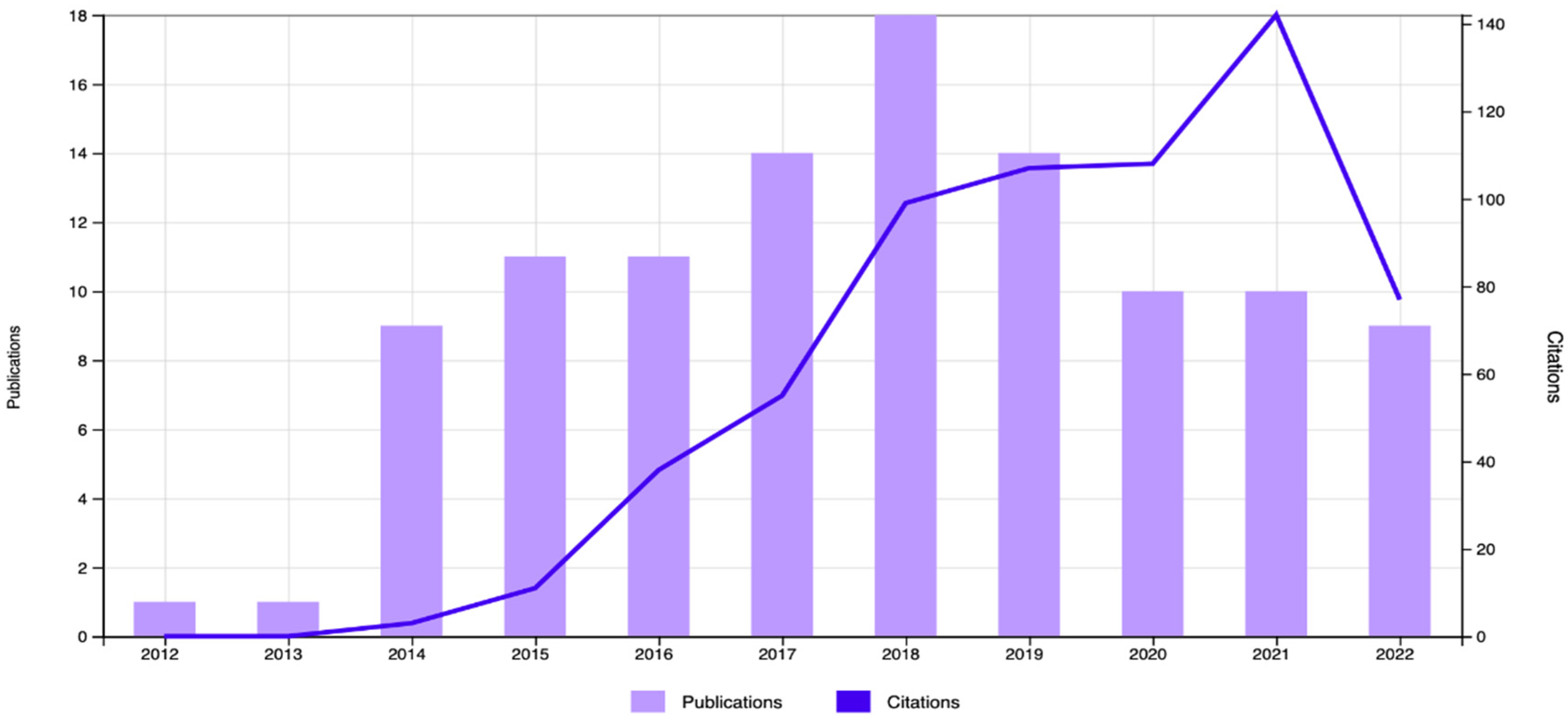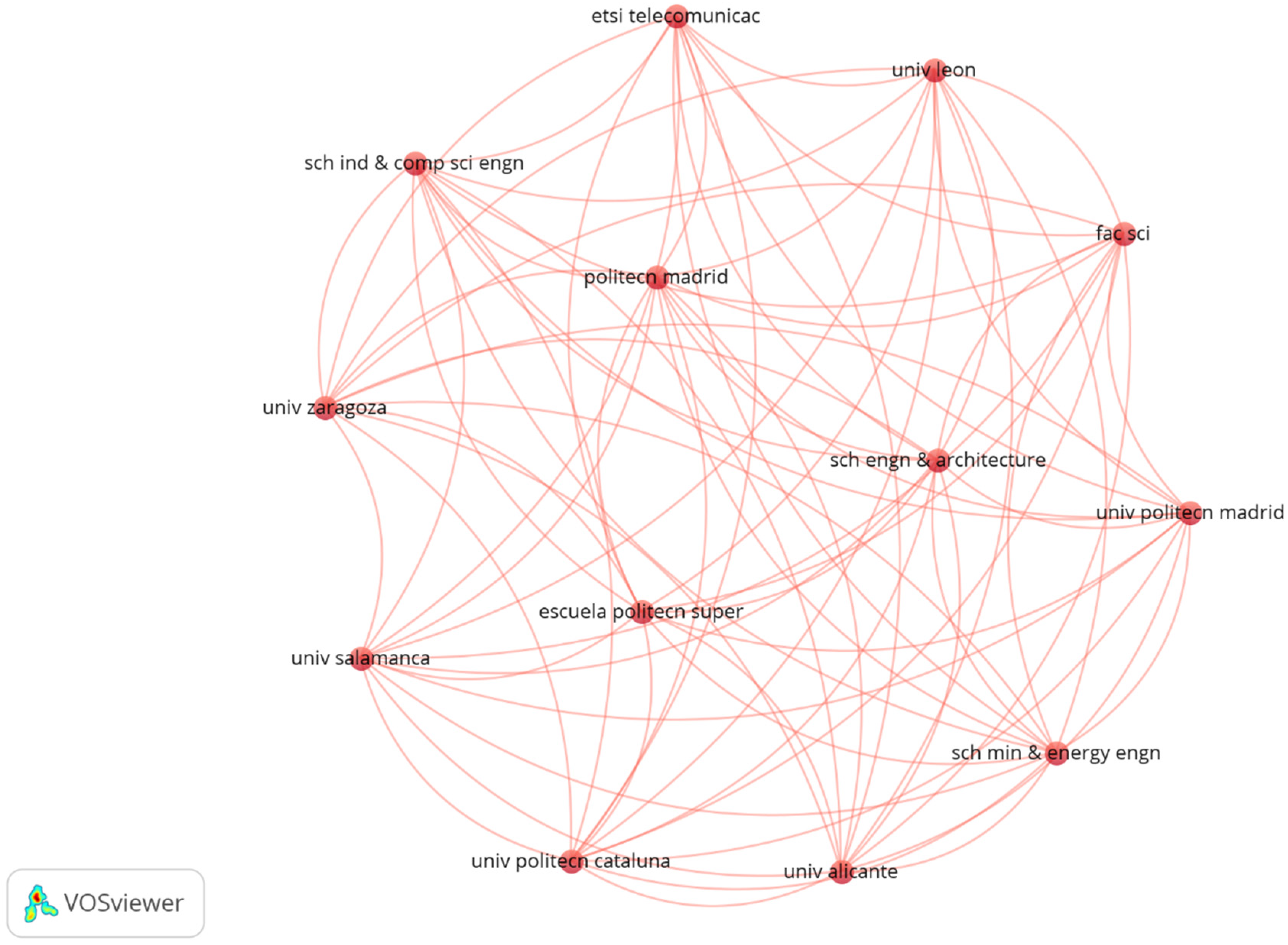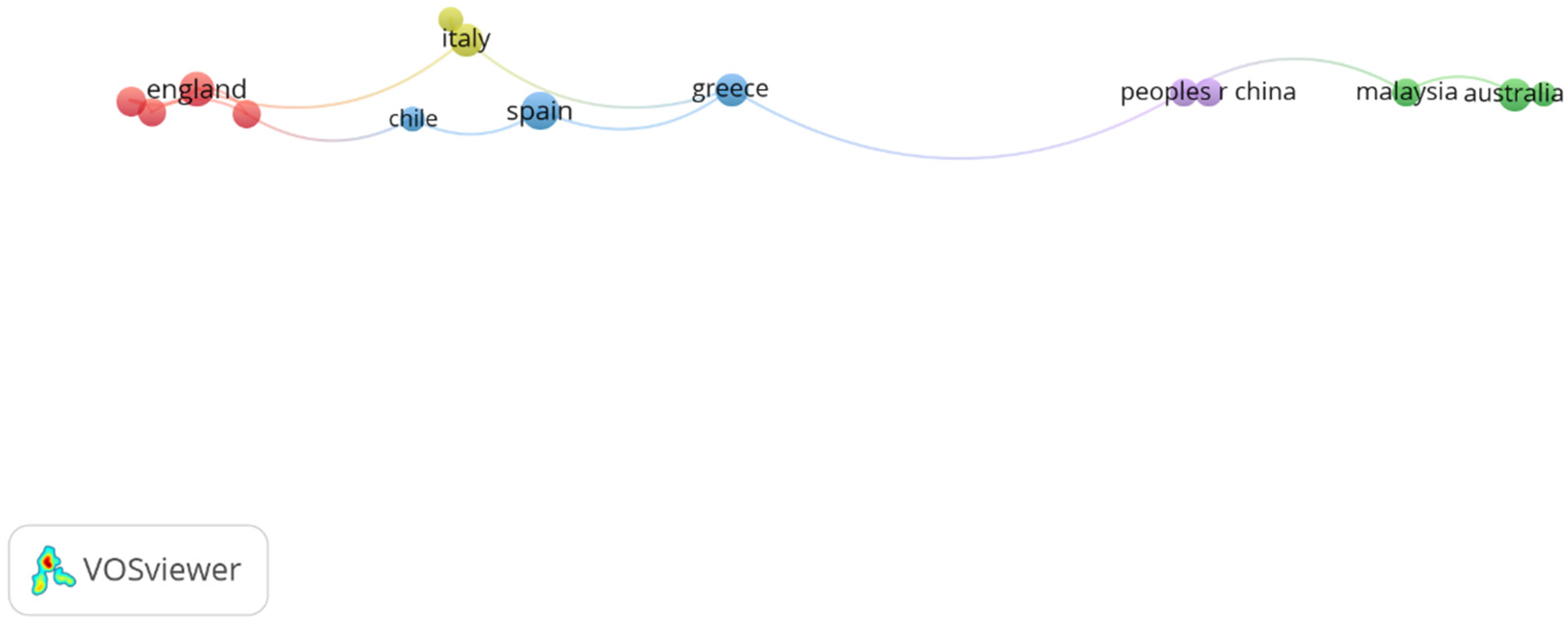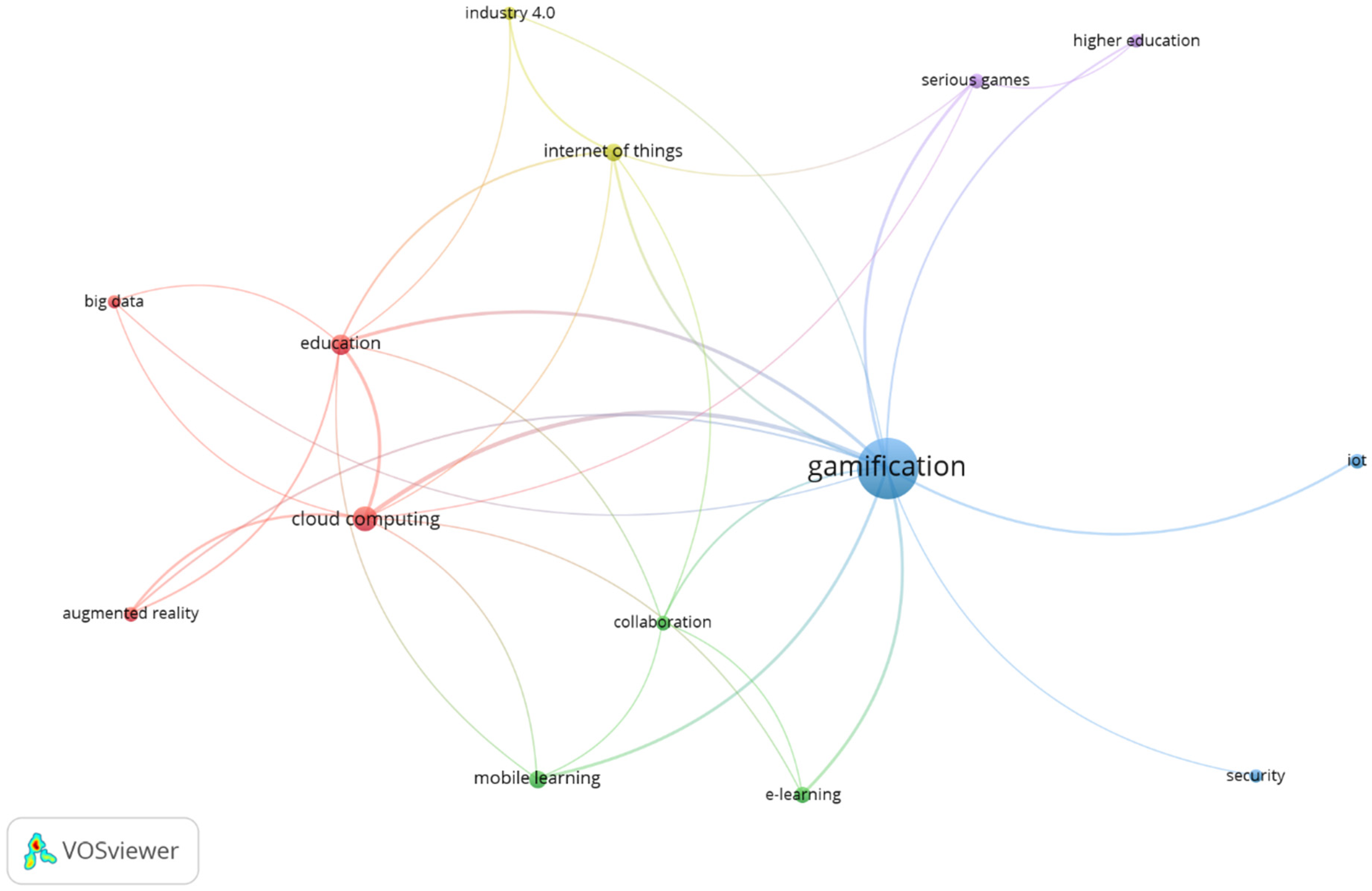Cloud Gamification: Bibliometric Analysis and Research Advances
Abstract
1. Introduction
- -
- To analyse the existing academic networks in the research field of Cloud Gamification.
- -
- To identify the most productive countries, authors and organisations.
- -
- To study the most relevant topics and trends in Cloud gamification research.
- RQ1: What is the evolution of knowledge about Cloud Gamification?
- RQ2: What is the geographical distribution of the production on Cloud Gamification?
- RQ3: Which publications, authors and papers have influenced research on Cloud Gamification?
- RQ4: What is the conceptual and thematic structure of the scientific literature on Cloud Gamification?
2. Materials and Methods
3. Results
3.1. Network Analysis
3.2. Analysis of the Authors’ Influence
- -
- Juho Hamari, Jonna Koivisto, and Harri Sarsa, 2014. “Does Gamification Work?—A Review of the Literature on Gamification”, in Proceedings of the 2014 47th Hawaii International Conference on System Sciences (HICSS ’14). IEEE Computer Society, USA, 3025–3034. https://doi.org/10.1109/HICSS.2014.377 (accessed on 15 September 2022).
- -
- Gabe Zichermann y Christopher Cunningham, 2011. “The Gamification by Design: Implementing Game Mechanics in Web and Mobile Apps”, O’Reilly Media.
- -
- Sebastian Deterding, Dan Dixon, Rilla Khaled, and Lennart Nacke, 2011. “From game design elements to gamefulness: defining “gamification”, in Proceedings of the 15th International Academic MindTrek Conference: Envisioning Future Media Environments (MindTrek ’11), Association for Computing Machinery, New York, NY, USA, 9–15. https://doi.org/10.1145/2181037.2181040 (accessed on 15 September 2022).
3.3. Analysis of Organisations and Countries
3.4. Co-Word Analysis
4. Discussion
5. Conclusions
Author Contributions
Funding
Data Availability Statement
Conflicts of Interest
References
- Vaquero, L.M.; Rodero-Merino, L.; Caceres, J.; Lindner, M. A break in the clouds: Towards a cloud definition. Acm Sigcomm Comput. Commun. Rev. 2009, 39, 50–55. [Google Scholar] [CrossRef]
- Cole, T.; Bhardwaj, A.K.; Garg, L.; Shrivastava, D.P. Investigation Into Cloud Computing Adoption Within the Hedge Fund Industry. J. Cases Inf. Technol. (JCIT) 2019, 21, 1–25. [Google Scholar] [CrossRef]
- Ishida, H.; Oishi, Y.; Morita, K.; Moriwaki, K.; Nakajima, T.Y. Development of a support vector machine based cloud detection method for MODIS with the adjustability to various conditions. Remote Sens. Environ. 2018, 205, 390–407. [Google Scholar] [CrossRef]
- Razzaq, A.; Asif, M.; Zia, U. Inter-ecosystem Interoperability on Cloud Survey to Solution. In Proceedings of the 2016 IEEE 4th International Conference on Future Internet of Things and Cloud (FiCloud), Vienna, Austria, 22–24 August 2016; pp. 348–355. [Google Scholar] [CrossRef]
- Rojo, T.; González-Limón, M.; Rodríguez-Ramos, A. Company–University Collaboration in Applying Gamification to Learning about Insurance. Informatics 2019, 6, 42. [Google Scholar] [CrossRef]
- Deterding, S.; Khaled, R.; Nacke, L.E.; Dixon, D. Gamification: Toward a Definition. In Proceedings of the Gamification Workshop Proceedings, Vancouver, BC, Canada, 7–12 May 2011; pp. 1–4. [Google Scholar]
- Queirós, R. PROud—A Gamification Framework Based on Programming Exercises Usage Data. Information 2019, 10, 54. [Google Scholar] [CrossRef]
- Jia, B.; Zhou, T.; Li, W.; Liu, Z.; Zhang, J. A Blockchain-Based Location Privacy Protection Incentive Mechanism in Crowd Sensing Networks. Sensors 2018, 18, 3894. [Google Scholar] [CrossRef]
- Marrone, M.; Hammerle, M. Relevant Research Areas in IT Service Management: An Examination of Academic and Practitioner Literatures. Commun. Assoc. Inf. Syst. 2017, 41, 517–543. [Google Scholar] [CrossRef]
- Capella, J.V.; Ors, R.; Bartet, L. Herramientas TIC para la innovación educativa en ingeniería. In Proceedings of the IV Encuentro Iberoamericano de Innovación, Investigación y Buenas Prácticas Educativas, Zaragoza, Spain, 7–8 September 2018. [Google Scholar]
- Wannapiroon, N.; Pimdee, P. Thai undergraduate science, technology, engineering, arts, and math (STEAM) creative thinking and innovation skill development: A conceptual model using a digital virtual classroom learning environment. Educ. Inf. Technol. 2022, 27, 5689–5716. [Google Scholar] [CrossRef]
- Swacha, J. Architecture of a Dispersed Gamification System for Tourist Attractions. Information 2019, 10, 33. [Google Scholar] [CrossRef]
- Kulpa, A.; Swacha, J. Application Programming Interface for the Cloud-Based Management of Gamified eGuides. Information 2020, 11, 307. [Google Scholar] [CrossRef]
- Tobarra, L.; Utrilla, A.; Robles-Gómez, A.; Pastor-Vargas, R.; Hernández, R. A cloud game-based educative platform architecture: The cyberscratch project. Appl. Sci. 2021, 11, 807. [Google Scholar] [CrossRef]
- Akhmetshin, E.M.; Vasilev, V.L.; Kozachek, A.V.; Meshkova, G.V.; Alexandrova, T.N. Analysis of Peculiarities of Using Digital Technologies in the University Professional Training Content. Int. J. Emerg. Technol. Learn. (Ijet) 2011, 16, 101–118. [Google Scholar] [CrossRef]
- Lytvynov, A.; Topolnyk, Y.; Chumak, L.; Prykhodkina, N.; Antoniuk, L.; Kramska, S. E-Learning Technologies for Future Teachers: Introduction of Educational Innovations in Higher School Practice. BRAIN Broad Res. Artif. Intell. Neurosci. 2022, 13 (Suppl. S1), 403–421. [Google Scholar] [CrossRef] [PubMed]
- Bucea-Manea-Țoniş, R.; Kuleto, V.; Gudei, S.C.D.; Lianu, C.; Lianu, C.; Ilić, M.P.; Păun, D. Artificial Intelligence Potential in Higher Education Institutions Enhanced Learning Environment in Romania and Serbia. Sustainability 2022, 14, 5842. [Google Scholar] [CrossRef]
- Halytska, O.B.; Lozytska, M. The main directions of Information and Communication Technologies implementation in the process of teaching german to Students of Philology. Inf. Technol. Learn. Tools 2022, 88, 56–73. [Google Scholar] [CrossRef]
- Danevičius, E.; Maskeliūnas, R.; Damaševičius, R.; Połap, D.; Woźniak, M. A Soft Body Physics Simulator with Computational Offloading to the Cloud. Information 2018, 9, 318. [Google Scholar] [CrossRef]
- Udjaja, Y. Gamification Assisted Language Learning for Japanese Language Using Expert Point Cloud Recognizer. Int. J. Comput. Games Technol. 2018, 2018, 9085179. [Google Scholar] [CrossRef]
- McWilliams, E.C.; Barbey, F.M.; Dyer, J.F.; Islam, M.N.; McGuinness, B.; Murphy, B.; Nolan, H.; Passmore, P.; Rueda-Delgado, L.M.; Buick, A.R. Feasibility of Repeated Assessment of Cognitive Function in Older Adults Using a Wireless, Mobile, Dry-EEG Headset and Tablet-Based Games. Front. Psychiatry 2021, 12, 574482. [Google Scholar] [CrossRef]
- Marchiori, M. Learning theway to the cloud: BD park. Concurr. Comput. Pract. Exper. 2019, 31, e4234.1–e4234.17. [Google Scholar] [CrossRef]
- Ramírez-Donoso, L.; Pérez-Sanagustín, M.; Neyem, A. MyMOOCSpace: Mobile cloud-based system tool to improve collaboration and preparation of group assessments in traditional engineering courses in higher education. Comput. Appl. Eng. Educ. 2018, 26, 1507–1518, Advance online publication. [Google Scholar] [CrossRef]
- Ramírez-Donoso, L.; Rojas-Riethmuller, J.S.; Pérez-Sanagustín, M.; Neyem, A.; Alario-Hoyos, C. MyMOOCSpace: A cloud-based mobile system to support effective collaboration in higher education online courses. Comput. Appl. Eng. Educ. 2017, 25, 910–926. [Google Scholar] [CrossRef]
- David, S.; Péter, E.; László, L. Gamification and driving decision support using the sensors of vehicles and smartphones. Intell. Decis. Technol. 2017, 11, 423–430. [Google Scholar] [CrossRef]
- Honic, M.; Kovacic, I. Model and data management issues in the integrated assessment of existing building stocks. Organ. Technol. Manag. Constr. Int. J. 2020, 12, 12148–12157. [Google Scholar] [CrossRef]
- Yin, J.; Sun, P.; Wen, Y.; Gong, H.; Liu, M.; Li, X.; You, H.; Gao, J.; Lin, C. Cloud3dview: An interactive tool for cloud data center operations. ACM SIGCOMM Comput. Commun. Rev. 2013, 43, 499–500. [Google Scholar] [CrossRef]
- Abid, G.; Contreras, F. Mapping Thriving at Work as a Growing Concept: Review and Directions for Future Studies. Information 2022, 13, 383. [Google Scholar] [CrossRef]
- Qiang, Y.; Tao, X.; Gou, X.; Lang, Z.; Liu, H. Towards a Bibliometric Mapping of Network Public Opinion Studies. Information 2022, 13, 17. [Google Scholar] [CrossRef]
- Hong, R.; Xiang, C.; Liu, H.; Glowacz, A.; Pan, W. Visualizing the Knowledge Structure and Research Evolution of Infrared Detection Technology Studies. Information 2019, 10, 227. [Google Scholar] [CrossRef]
- Van Eck, N.J.; Waltman, L. Visualizing bibliometric networks. In Measuring Sscholary Impact: Methods and Practice; Ding, Y., Rousseau, R., Wolfram, D., Eds.; Springer: Berlin/Heidelberg, Germany, 2014; pp. 285–320. Available online: https://www.doi.org/10.1007/978-3-319-10377-8_13 (accessed on 12 October 2022).
- De Bellis, N. Bibliometrics and Citation Analysis: From the Science Citation Index to Cybermetrics; Scarecrow Press: Lanham, MD, USA, 2009. [Google Scholar] [CrossRef]
- Donthu, N.; Kumar, S.; Mukherjee, D.; Pandey, N.; Lim, W.M. How to conduct a bibliometric analysis: An overview and guidelines. J. Bus. Res. 2021, 133, 285–296. [Google Scholar] [CrossRef]
- Liu, H.; Liu, Y.; Wang, Y.; Pan, C. Hot topics and emerging trends in tourism forecasting research: A scientometric review. Tour. Econ. 2019, 25, 448–468. [Google Scholar] [CrossRef]
- Ellegaard, O.; Wallin, J.A. The bibliometric analysis of scholarly production: How great is the impact? Scientometrics 2015, 105, 1809–1831. [Google Scholar] [CrossRef]
- Van Raan, A.F.J. For your citations only? Hot topics in bibliometric analysis. Meas. Interdiscip. Res. Perspect. 2005, 3, 50–62. [Google Scholar] [CrossRef]
- Zhang, J.; Yu, Q.; Zheng, F.; Long, C.; Lu, Z.; Duan, Z. Comparing keywords plus of WOS and author keywords: A case study of patient adherence research. J. Assoc. Inf. Sci. Technol. 2016, 67, 967–972. [Google Scholar] [CrossRef]
- Benckendorff, P. Themes and trends in Australian and New Zealand tourism research: A social network analysis of citations in two leading journals (1994–2007). J. Hosp. Tour. Manag. 2009, 16, 1–15. [Google Scholar] [CrossRef]
- Zupic, I.; Cater, T. Bibliometric Methods in Management and Organization. Organ. Res. Methods 2015, 18, 429–472. [Google Scholar] [CrossRef]
- Markoulli, M.P.; Lee, C.I.; Byington, E.; Felps, W.A. Mapping human resource management: Reviewing the field and charting future directions. Hum. Resour. Manag. Rev. 2017, 27, 367–396. [Google Scholar] [CrossRef]
- Cobo, M.J.; López-Herrera, A.G.; Herrera-Viedma, E.; Herrera, F. Science mapping software tools: Review, analysis, and cooperative study among tools. J. Am. Soc. Inf. Sci. Technol. 2011, 62, 1382–1402. [Google Scholar] [CrossRef]
- González-Limón, M.; Rodríguez-Ramos, A.; Maldonado, C. A Bibliometric analysis of Experimental Economics and progress of the research field. In Proceedings of the 4th International Conference on Advanced Research Methods and Analytics, Valencia, Spain, 29 June–1 July 2022. [Google Scholar]
- González-Limón, M.; Rodríguez-Ramos, A. Economía del Envejecimiento: Análisis bibliométrico y avances en este campo de investigación. In Envejecimiento, Salud y Cambio Climático; Fundación Mapfre: Madrid, Spain, 2022; ISBN 978-84-9844-824-5. [Google Scholar]
- Cantos-Mateos, G.; Vargas-Quesada, B.; Zulueta García, M.A.; Chinchilla-Rodríguez, Z. Estudio Comparativo Sobre la Visualización de Redes de Co-words a Través de los Descriptores Del Science Citation Index y de Medline. In Atas de I Congresso ISKO Espanha e Portugal/XI Congresso ISKO Espanha; Faculdade de Letras da Universidade do Porto: Oporto, Portugal, 2013; pp. 173–190. ISBN 978-989-8648-10-5. [Google Scholar]
- Gálvez, G. Evolución del campo de investigación de los Social Media mediante mapas de la ciencia (2008–2017). Commun. Soc. 2019, 32, 61–76. [Google Scholar] [CrossRef]
- Pappas, G.; Siegel, J.; Vogiatzakis, I.; Politopoulos, K. Gamification and the Internet of Things in Education. In Handbook of Intelligent Techniques in Educational Process Chapter: 15; Springer: Berlin/Heidelberg, Germany, 2022; pp. 317–339. [Google Scholar] [CrossRef]
- Behl, A.; Jayawardena, N.; Pereira, V.; Islam, N.; Del Giudice, M.; Choudrie, J. Gamification and e-learning for young learners: A systematic literature review, bibliometric analysis, and future research agenda. Technol. Forecast. Soc. Chang. 2022, 176, 121445. [Google Scholar] [CrossRef]
- Camps, D. Análisis bibliométrico de reportes de casos publicados en los volúmenes 46 y 47 de la revista Patología. Patol. Rev. Lat. 2010, 48, 230–233. [Google Scholar]






| Inclusion Criteria | Exclusion Criteria | Bibliometric Indicator |
|---|---|---|
| CI1: Period: From the first published document until 31 July 2022 | EX1: Documents published after 31 July 2022 | Number of documents per year of publication |
| CI2: All categories in WoS | EX2: None | Number of citations per year |
| CI3: Type of documents: all. Proceeding Papers, Articles, Early-Access Articles, Review Articles, Book Chapters | EX3: None | Number of documents by typology |
| CI4: Language | EX4: None | Number of documents by typology |
| CI5: Topics “Cloud” AND topics “Gamification”. | EX5: Filtering of documents containing the subject matter | Most prolific countries Most productive organisations/institutions Most productive authors |
| Document Types | N° |
|---|---|
| Meeting | 66 |
| Article | 39 |
| Review article | 3 |
| Total | 108 |
| Web of Science Categories (10) | Number of Publications | Percentage |
|---|---|---|
| Computer Science Theory Methods | 29 | 26.852 |
| Computer Science Information Systems | 24 | 22.222 |
| Engineering Electrical Electronics | 20 | 18.519 |
| Education Educational Research | 19 | 17.593 |
| Computer Science Interdisciplinary Applications | 14 | 12.963 |
| Computer Science Artificial Intelligence | 12 | 11.111 |
| Education Scientific Disciplines | 10 | 9.259 |
| Telecommunications | 10 | 9.259 |
| Computer Science Cybernetics | 9 | 8.333 |
| Computer Science Hardware Architecture | 7 | 6.481 |
| Titles of Journals or Meetings (10) | Number of Publications | % of 108 |
|---|---|---|
| Information | 4 | 3.704 |
| 2014 IEEE ACM 7th International Conference on Utility and Cloud Computing UCC | 3 | 2.778 |
| Lecture Notes in Computer Science | 3 | 2.778 |
| 2018 IEEE 6th International Conference on Future Internet of Things and Cloud Workshops W Ficloud 2018 | 2 | 1.852 |
| Advances in Intelligent Systems and Computing | 2 | 1.852 |
| Applied Sciences Basel | 2 | 1.852 |
| Communications in Computer and Information Science | 2 | 1.852 |
| Computer Applications in Engineering Education | 2 | 1.852 |
| Edulearn15, 7th International Conference on Education and New Learning Technologies | 2 | 1.852 |
| Elearning and Software for Education | 2 | 1.852 |
| Authors | Number of Publications | Citations | Organization |
|---|---|---|---|
| Ali, Raian | 2 | 28 | Bournemouth University, United Kingdom |
| Dalpiaz, Fabiano | 2 | 28 | Utrecht University. Utrecht, Netherlands |
| Hosseini, Mahmood | 2 | 28 | Eastern Mediterranean University Fac Engn Famagusta, North Cyprus, Turkey |
| Shahri, Alimohammad | 2 | 28 | Leyton UK London, England |
| Neyem, Andres | 2 | 22 | Pontificia Universidad Catolica de Chile Ciencias Computac Santiago, Chile |
| Perez-Sanagustin, Mar | 2 | 22 | Universite Toulouse 1 Capitole Inst Rech Informat Toulouse Toulouse, France |
| Ramirez-Donoso, Luis | 2 | 22 | Pontificia Catolica Univ Chile Ciencias Computac Macul, Chile |
| Swacha, Jacub | 3 | 10 | Univ Szczecin, Szczecin, Poland |
| Abdullahi, Hamit | 2 | 9 | Abu Dhabi University Coll Engn Abu Dhabi, U Arab Emirates |
| Ahmed, Masud | 2 | 9 | Abu Dhabi University Coll Engn Abu Dhabi, U Arab Emirates |
Publisher’s Note: MDPI stays neutral with regard to jurisdictional claims in published maps and institutional affiliations. |
© 2022 by the authors. Licensee MDPI, Basel, Switzerland. This article is an open access article distributed under the terms and conditions of the Creative Commons Attribution (CC BY) license (https://creativecommons.org/licenses/by/4.0/).
Share and Cite
González-Limón, M.; Rodríguez-Ramos, A. Cloud Gamification: Bibliometric Analysis and Research Advances. Information 2022, 13, 579. https://doi.org/10.3390/info13120579
González-Limón M, Rodríguez-Ramos A. Cloud Gamification: Bibliometric Analysis and Research Advances. Information. 2022; 13(12):579. https://doi.org/10.3390/info13120579
Chicago/Turabian StyleGonzález-Limón, Myriam, and Asunción Rodríguez-Ramos. 2022. "Cloud Gamification: Bibliometric Analysis and Research Advances" Information 13, no. 12: 579. https://doi.org/10.3390/info13120579
APA StyleGonzález-Limón, M., & Rodríguez-Ramos, A. (2022). Cloud Gamification: Bibliometric Analysis and Research Advances. Information, 13(12), 579. https://doi.org/10.3390/info13120579







